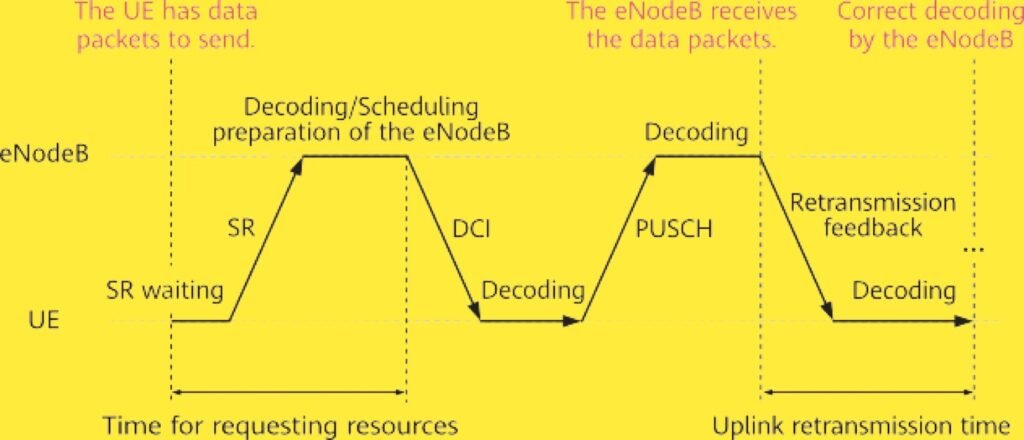Before diving into how URLLC (Ultra-Reliable Low-Latency Communication) is implemented in 5G, it’s essential to understand the latency and reliability benchmarks set in 4G communications, as defined in 3GPP TR 25.913.
4G Latency and Reliability Requirements.
In 4G networks, the user-plane latency on the RAN (Radio Access Network) side is a critical factor, with a target of approximately 10 milliseconds (ms).
Table below Target user-plane latency on the 4G RAN side.
| Indicator | Definition in 3GPP Specifications | Target Value |
|---|---|---|
| User-plane latency | The user-plane latency is defined in terms of the one-way transit time of a data packet at the IP layer between a UE and a RAN edge node. The RAN edge node is a node providing the RAN interface toward the core network. | Downlink: 5 msUplink: 5 ms |
This latency is primarily influenced by several factors, including the time required to request resources, the Transmission Time Interval (TTI), the time it takes for the UE (User Equipment) and eNodeB (evolved Node B) to process data packets, and the Hybrid Automatic Repeat Request (HARQ) time. Figure beow illustrates the uplink user-plane latency in the 4G RAN.

- Data Packet Processing Time: This depends on the size of the data packet and the processing capabilities of both the UE and eNodeB. However, this processing time is challenging to reduce significantly, as it is inherently tied to the nature of the data being handled.
- Resource Request and Assignment Time: Efforts to reduce latency in 4G have largely focused on minimizing the time spent waiting for resource scheduling requests (SRs) and their assignment. Techniques like preallocation and semi-persistent scheduling have been introduced to streamline this process, thereby reducing latency.
- Transmission Time Interval (TTI): Another critical latency reduction technique involves shortening the TTI, which is the time duration in which data is transmitted. Traditionally, TTI in 4G was one subframe long (1 ms), but by shortening this to two or three OFDM (Orthogonal Frequency Division Multiplexing) symbols, latency is further reduced.
- HARQ Time: HARQ is a process that ensures data integrity by allowing the receiver to request retransmissions of corrupted data packets. Reducing the time interval from when a UE receives Downlink Control Information (DCI) to when it sends HARQ feedback (ACK/NACK) is another method of lowering latency.
As of 3GPP Release 15, through these various optimizations, the theoretical user-plane latency in 4G networks has been reduced to less than 5 ms in both downlink and uplink scenarios. These improvements paved the way for even more stringent requirements in 5G URLLC, where ultra-low latency and high reliability are essential for emerging applications like autonomous driving and industrial automation.
References.
- 3GPP TS 22.104, Service requirements for cyber-physical control applications in vertical domains; Stage 1 (Release 17).
- 3GPP TS 23.203, Policy and charging control architecture (Release 17).
- 3GPP TR 25.913, Requirements for Evolved UTRA (E-UTRA) and Evolved UTRAN (E-UTRAN) (Release 9).
- 3GPP TS 38.214, NR; Physical layer procedures for data (Release 16).
- 3GPP TS 22.261, Service requirements for the 5G system; Stage 1 (Release 17).
- 3GPP TS 38.211, NR; Physical channels and modulation (Release 16).
- Scheduling. Feature Parameter Description, Huawei Technologies Co., Ltd., LTE eRAN17.1.
- 3GPP TS 38.212, NR; Multiplexing and channel coding (Release 15).
- 3GPP TS 38.213, NR; Physical layer procedures for control (Release 16).
- 3GPP TS 38.323, NR; Packet Data Convergence Protocol (PDCP) specification (Release 16).
- 3GPP TS 38.331, NR; Radio Resource Control (RRC) protocol specification (Release 16).
- 3GPP TR 38.913, Study on Scenarios and Requirements for Next Generation Access Technologies (Release 16).
- URLLC. Feature Parameter Description, Huawei Technologies Co., Ltd., 5G RAN5.1.
- Short TTI. Feature Parameter Description, Huawei Technologies Co., Ltd., LTE eRAN17.1.
- Air Interface Latency Optimization. Feature Parameter Description, Huawei Technologies Co., Ltd., LTE eRAN17.1.